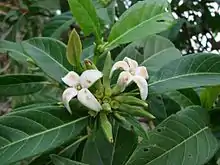Alibertia edulis
Alibertia edulis is a species of tree in the family Rubiaceae. It is native to the tropical forests of the Americas.[1]
| Alibertia edulis | |
|---|---|
 | |
| Alibertia edulis leaves and flowers | |
| Scientific classification | |
| Kingdom: | Plantae |
| Clade: | Tracheophytes |
| Clade: | Angiosperms |
| Clade: | Eudicots |
| Clade: | Asterids |
| Order: | Gentianales |
| Family: | Rubiaceae |
| Genus: | Alibertia |
| Species: | A. edulis |
| Binomial name | |
| Alibertia edulis (Rich.) A.Rich. ex DC. | |

The unripe fruit of Alibertia edulis
Description
Alibertia edulis is an evergreen dioecious tree up to 25 feet (7.5m) tall at maturity, with light brownish bark and opposite, ovate, dark green leaves that have a smooth margin. The flowers are tubular to trumpet-shaped, white, hairy, in 4-8" panicles, with 4-5 petals. The fruit is yellow, egg-shaped, ovate, edible, and made into jam or juices. The fruits are collected from trees in the wild, as this species is seldom cultivated.[2]
References
- Grandtner, M. M.; Chevrette, Julien (2013). Dictionary of Trees, Volume 2: South America: Nomenclature, Taxonomy and Ecology. Academic Press. pp. 22–23. ISBN 9780123969545.
- "Alibertia edulis". bananasraras.org (Rare bananas). Retrieved 16 January 2015.
This article is issued from Wikipedia. The text is licensed under Creative Commons - Attribution - Sharealike. Additional terms may apply for the media files.